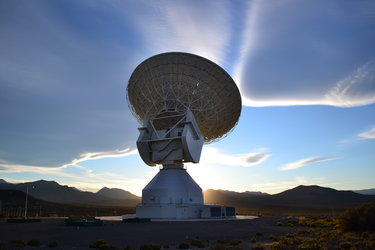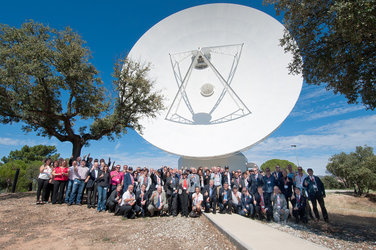ESA station tracks Earth flyby mission
An ESA deep-space ground station will lend a helping ear as Japan’s Hayabusa-2 asteroid mission visits Earth on Thursday.
Hayabusa is on an audacious six-year journey to rendezvous with the 900 m-diameter asteroid Ryugu, deliver several landers, snatch a sample of material and then return to Earth in 2020.
The high-tech craft will make an Earth flyby today, a year to the day after launch, gaining gravitational energy to enable it to reach Ryugu’s orbit in 2018.
The closest approach will occur at about 10:08 GMT (11:08 CET), some 3000 km above the Pacific Ocean.
As it departs Earth, the only radio visibility for communicating with the craft will be from the Southern Hemisphere, and that’s when ESA’s 35 m-diameter deep-space tracking dish in Malargüe, Argentina, will go into action.

“Our first communication slot occurs on 5 December, just two days after closest approach, and lasts four hours,” says ESA’s Maite Arza.
“We’ll provide four more tracking passes in December. All of the passes will include sending commands and receiving telemetry on its health and status.”
Like all antennas in the Agency’s Estrack ground station network, the Malargüe antenna will be remotely operated by engineers at ESA’ ESOC operations centre, Darmstadt, Germany.
On competition of each pass, all data received from Hayabusa will be transmitted to the mission control team of the Japan Aerospace Exploration Agency.
The flyby is also being covered from by NASA’s deep-space station in Canberra, Australia.
First-ever tracking for Japanese deep-space mission
This month’s helping ear is part of an overall effort that will see the Malargüe dish providing hundreds of tracking hours during the Hayabusa-2 mission.
The sophisticated technology and location of ESA’s station will enable Hayabusa-2, normally tracked from Japan, to deliver significantly more science data and provide coverage when Japanese stations are out of visibility.

In the past, ESA has helped with Japan’s Earth and astronomy missions, including Oicets and Astro-F, but this is the first tracking provided for a deep-space mission.
Hayabusa-2 was launched on 3 December 2014, and has significant European participation.
In addition to carrying three 1 kg ‘hopper’ landers, it carries the larger Mascot landing package from the DLR German Aerospace Center and France’s CNES space agency.















 Germany
Germany
 Austria
Austria
 Belgium
Belgium
 Denmark
Denmark
 Spain
Spain
 Estonia
Estonia
 Finland
Finland
 France
France
 Greece
Greece
 Hungary
Hungary
 Ireland
Ireland
 Italy
Italy
 Luxembourg
Luxembourg
 Norway
Norway
 The Netherlands
The Netherlands
 Poland
Poland
 Portugal
Portugal
 Czechia
Czechia
 Romania
Romania
 United Kingdom
United Kingdom
 Slovenia
Slovenia
 Sweden
Sweden
 Switzerland
Switzerland



























